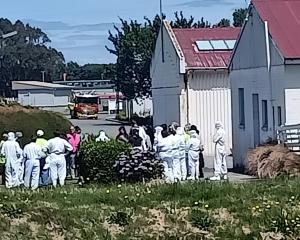But they are holding their own.
Four nationally critical Awakopaka skinks from the Homer Saddle in Fiordland, with fewer than 20 of the animals ever recorded, have been born in a special climate-controlled facility at Auckland Zoo.
These highly anticipated babies — one birth captured on video — are the offspring of a pregnant adult female urgently translocated from the saddle last November as part of a collaborative effort by the zoo, Department of Conservation (Doc) and Ngāi Tahu to prevent the extinction of this rare species.
Born in late April, the tiny offspring weighed just 0.32g-0.42g — about the same weight as a third of a paperclip — and were about 7cm long.
While one has since died, the remaining three have now grown to about half a gram and are progressing well — though remain incredibly delicate at this size.
Auckland Zoo ectothems leader Dave Laux said the animals were incredibly small but they were growing every day.
"They are super delicate creatures.

"So we have to really watch their environmental parameters."
They needed to balance constantly keeping an eye on them and giving them confidence.
The climate-controlled facility built at the zoo in 2023 mirrored their habitat in Fiordland.
"You can be sitting out in the sun in Fiordland with all the heat coming off the rocks and it is very comfortable.
"Then the cloud comes over, the rain and wind comes in and it is freezing.
"They say you are never half an hour away from death in Fiordland."
Auckland Zoo animal care and conservation head Richard Gibson said the species was only discovered in 2014 and was thought to be on the very precipice of extinction.

They are known from only a handful of hectares of steep, rugged bolder habitat near the Homer Saddle where beech and tussock masts, or heavy seeding events, result in an explosion of mammalian predators including rats and mice.
Doc undertakes regular and extensive rodent control across the terrain as part of their ongoing effort to protect skinks in the wild and give the species a fighting chance.
Dr Laux did not know the gestation period for the mother.
The find of the mother on a bluff has motivated Doc to search other bluffs after the snow retreats this summer.
New Zealand has at least 126 endemic species of skink and gecko, of which 92% are either "threatened", or "at risk" of extinction.
Dr Laux said animals such as hoihoi and kākāpō got the headlines but skinks were crucial too.
They played an important role in the ecology of New Zealand’s varied habitats.
Mr Gibson said "it was urgent that we recognise and prioritise focused conservation efforts for many, or we risk losing them for ever".











